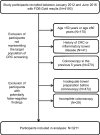Variation of diagnostic performance of fecal immunochemical testing for hemoglobin by sex and age: results from a large screening cohort
- PMID: 29670403
- PMCID: PMC5896664
- DOI: 10.2147/CLEP.S155548
Variation of diagnostic performance of fecal immunochemical testing for hemoglobin by sex and age: results from a large screening cohort
Abstract
Objective: Fecal immunochemical tests (FITs) for hemoglobin in stool are increasingly used for colorectal cancer screening. Reported sensitivities and specificities have strongly varied between studies, but it is unclear to what extent such variation reflects differences between tests or between study population characteristics. We aimed to evaluate the key parameters of FIT performance for detecting advanced neoplasia (AN) according to sex and age.
Methods: Sex- and age-specific sensitivity, specificity, positive predictive values (PPVs) and negative predictive values (NPVs) for detecting AN of a quantitative FIT (FOB Gold®) were evaluated among 3211 men and women aged 50-79 years who underwent screening colonoscopy in Germany.
Results: At the cutoff recommended by the manufacturer (17 µg hemoglobin/g feces), sensitivity was higher (51.2% versus 34.7%, p=0.004) and specificity was lower (91.0% versus 94.8%, p<0.001) among 65-79 year-old participants compared with 50-64 year-old participants. PPVs and NPVs did not differ significantly between age groups. However, higher NPVs were observed among women compared with men (94.7% versus 92.5%, p=0.015). Specificity was also higher among women compared with men (94.7% versus 92.3%, p=0.007), while there was only a little variation in sensitivity (40.3% versus 41.8%, p=0.789) according to sex. In joint stratification by both factors, sensitivity ranged from 34.1% (95% CI 24.2%-45.2%) in 50-64 year-old women to 51.4% (95% CI 39.3%-63.3%) in 65-79 year-old men (p=0.029). The observed age and sex differences were highly consistent across a wide range of alternative cutoffs from 10 to 50 µg hemoglobin/g feces.
Conclusion: There are major differences in diagnostic performance parameters according to sex and age, which should receive careful attention in the interpretation and comparison of results of FIT-based colorectal cancer screening studies.
Keywords: colorectal cancer; fecal immunochemical tests; hemoglobin; screening.
Conflict of interest statement
Disclosure The authors report no conflicts of interest in this work.
Figures
References
-
- Ferlay J, Soerjomataram I, Dikshit R, et al. Cancer incidence and mortality worldwide: sources, methods and major patterns in GLOBOCAN 2012. Int J Cancer. 2015;136(5):E359–E386. - PubMed
-
- Hewitson P, Glasziou P, Watson E, Towler B, Irwig L. Cochrane systematic review of colorectal cancer screening using the fecal occult blood test (hemoccult): an update. Am J Gastroenterol. 2008;103(6):1541–1549. - PubMed
-
- Scholefield JH, Moss SM, Mangham CM, Whynes DK, Hardcastle JD. Nottingham trial of faecal occult blood testing for colorectal cancer: a 20-year follow-up. Gut. 2012;61(7):1036–1040. - PubMed
-
- Shaukat A, Mongin SJ, Geisser MS, et al. Long-term mortality after screening for colorectal cancer. N Engl J Med. 2013;369(12):1106–1114. - PubMed
-
- Park DI, Ryu S, Kim YH, et al. Comparison of guaiac-based and quantitative immunochemical fecal occult blood testing in a population at average risk undergoing colorectal cancer screening. Am J Gastroenterol. 2010;105(9):2017–2025. - PubMed
LinkOut - more resources
Full Text Sources
Other Literature Sources


